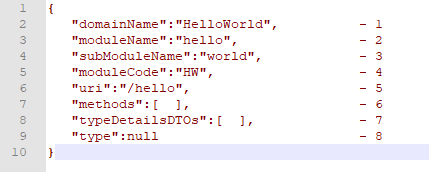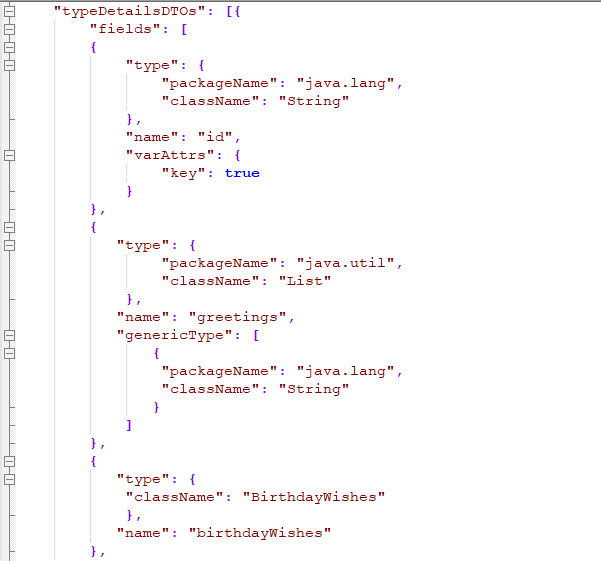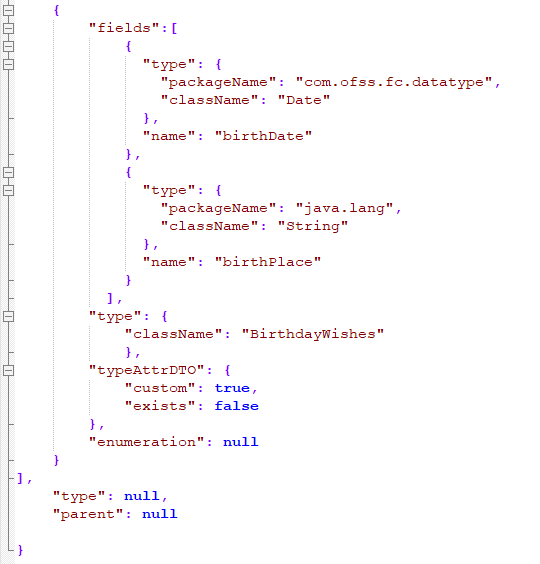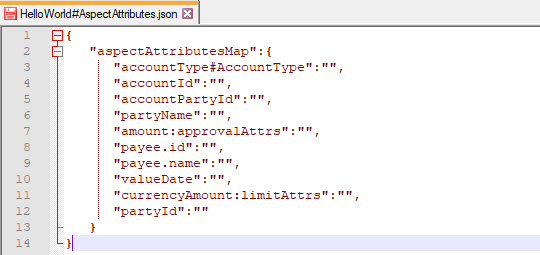4.3 Write JSON
This is the most important part of toolkit. The toolkit takes this JSON as input in the form of JSON file. It is where you need to write the details pertaining to the Service to be generated.
The details for the “Hello World” service to be put in the JSON is given below :
For details of each and every field of the input JSON please refer section 6(JSON Explained). It is known that every functionality in OBAPI runs on underlying domain.
This JSON for the Hello World has a domain name “HelloWorld” which belongs to a submodule “world” of the “hello” module. You’ll be able to reach “HelloWorld” resource at path “/hello”.
HelloWorld functionality allows various operations such as ‘create’, ‘read’ which is provided in the JSON as an array of methods and it consists of various fields which are to be provided in typeDetailsDTO’s. The type(8) represents the type of domain name. If it is not provided by the user, then it is deduced from domain name, module name and sub module name. The typeDetailsDTO’s (7) and methods (6) details put in the HelloWorld input JSON is given below:
The above snippet is of the typeDetailsDTO’s in which fields or variables to be declared in the HelloWorld. It is an array in which each element consists of fields,type, typeAttrDTO and enumeration. User has to define one of these fields as key of the HelloWorld domain. Here the key is ‘id’ variable (as can be seen its attributes ‘key’ carries ‘true’ value. Another field is a list of strings followed by ‘birthdayWishes’ of type BirthdayWishes. For details of preparing fields array refer the section : JSON Explained..
The above snippet is of another element of typeDetailsDTO array. It represents the type BirthdayWishes comprising of the fields ‘birthDate’ and ‘birthPlace’.The typeDetailsDTO has certain attributes like typeAttrDTO and enumeration.
The above snippet is of the ‘methods’ in the HelloWorld, which again is an array, each element representing one method. In HelloWorld we have two methods create and read hence two elements. The methods has certain attributes like taskType, moduleType and txnType. If the ‘entitlements’ is provided empty value the tool will generate default entitlements for it. For details regarding the possible values in there attributes please refer section : JSON Explained.
The above snippet is of the version folder which contains AspectAttributesConfig.json and version.properties. version.properties contains the OBAPI version(for which the artifacts are to be generated). Based on the version, the corresponding aspectAttributes are selected from the AspectAttributesConfig.json. This JSON consists of different transaction types with their corresponding attributes. With the help of this JSON and txn type mentioned in the methods of input JSON, the domainName#AspectAttributes.json is generated which is shown in the below Figure. Now ,the user has to fill the corresponding attributes in domainName#AspectAttributes.json from input JSON. For that purpose user has to check the fields (declared in the domain) corresponding to each attributes. Aspect attributes are mandatory.
If any operation added has a task Aspect “approval” or ”limit” then user has to fill the corresponding data in this file else not required.
accountType#AccountType : Value of Enumeration of AccountType (e.g #CSA)
accountId : attribute used to define the accountId
accountPartyId : attribute used to define the account Party Id
partyName.fullName : Name of the Party from attributes
amount:approvalAttrs: attribute of varAttr type amount which will be used as approval amount
Parent topic: Write your First Service





